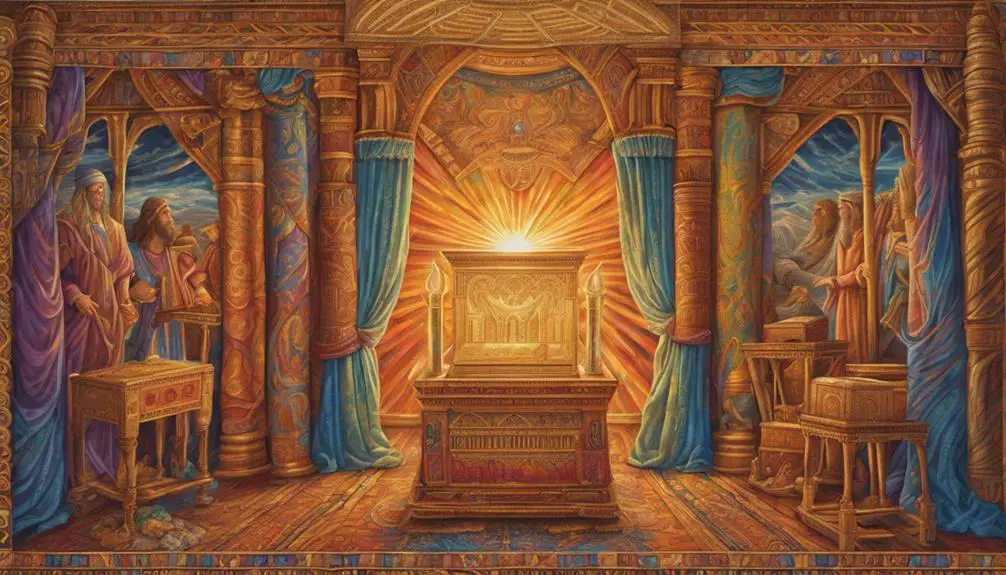Explore the rich symbolism of tapestry in the Bible, revealing layers of meaning in the threads of divine narrative and human connection.

Tapestry in the Bible
Just as a weaver intricately interlaces threads to create a masterpiece, the Bible weaves tapestry into its narrative, offering layers of meaning and beauty.
You'll find that tapestries are more than mere backdrops in biblical settings; they serve as powerful symbols of covenant, craftsmanship, and divine presence, particularly within the Tabernacle.
As you explore the historical context, symbolism, and the meticulous details of these woven artworks, you'll uncover how they reflect broader themes of creation, redemption, and the human connection to the divine.
This journey will leave you pondering the profound ways in which these ancient textiles mirror the fabric of spiritual life.
Key Takeaways
- Tapestries in the Bible symbolized wealth, power, and divine connections, reflecting the cultural and spiritual significance of the time.
- The craftsmanship and artistic techniques of biblical tapestries, including innovative dyeing and weaving, narrated stories of creation, covenant, and redemption.
- Colors and designs in tapestries carried theological meanings, showcasing the influence of Near Eastern culture on biblical narratives.
- Modern artists incorporate biblical tapestry motifs to explore spirituality and societal themes, demonstrating the enduring relevance of these ancient narratives.
Historical Context of Tapestry

To fully appreciate the role of tapestry in the Bible, it's crucial to understand its historical context, which reveals its significance in ancient cultures and religious practices. Tapestries weren't merely decorative; they were symbols of wealth, power, and divine connections. This significance was largely due to the materials and craftsmanship involved, which were direct products of burgeoning trade routes. These routes didn't just facilitate the exchange of goods; they were conduits for artistic influence and cultural exchange.
You'll find that the evolution of tapestry art was significantly shaped by these interactions. As traders moved from the East to the West, they didn't merely bring silk and dyes; they brought ideas, styles, and techniques. This cross-pollination of artistic influence led to a rich tapestry of styles—quite literally. The Bible's references to tapestries reflect this complexity, showcasing not just the physical beauty of these artworks but their deep cultural and spiritual resonance.
Understanding the historical backdrop of tapestry in the Bible helps you grasp its multifaceted role. It wasn't just backdrop or finery; it was a testament to the interconnectedness of ancient civilizations and their shared human experience, mediated through trade routes and artistic influence.
Tapestry in the Tabernacle

Understanding the historical significance and cultural exchange behind tapestry art enriches our appreciation for its specific use in the construction of the Tabernacle, as described in the Bible. This sacred structure, pivotal to ancient Israelite worship, was adorned according to divine instructions, showcasing the deep intertwining of religious belief and artistic expression. These directives didn't merely aim for functionality but were deeply imbued with an understanding of worship aesthetics, elevating the act of worship through visual and material magnificence.
The tapestries used weren't arbitrary decorations but were crafted under precise divine guidance, highlighting the importance of beauty and sanctity in the worship space. The materials chosen, the colors used, and the craftsmanship required reflected a profound respect for divine worship. This reverence for the aesthetic elements in worship spaces underlines a broader principle in religious practice: the environment in which worship occurs matters deeply. It's a testament to the belief that beauty and holiness are interconnected, and that through these artistic expressions, worshippers could encounter the divine in a space that transcended the ordinary.
In analyzing the role of tapestry within the Tabernacle, you're delving into a rich narrative of how art and faith intersect, revealing a layered understanding of how ancient societies viewed the act of worship and the spaces designated for it.
Symbolism and Significance

Delving into the symbolism and significance of tapestry in the Tabernacle reveals layers of meaning that extend beyond mere decoration, embodying rich theological and cultural narratives. The intricate designs and colors chosen weren't arbitrary but were imbued with deep spiritual and cultural significance, reflecting the beliefs and values of the time.
- Color Meanings: Each color woven into the tapestry held specific meanings. For example, blue often represented divinity and the heavens, red symbolized sacrifice and redemption, while purple—a blend of blue and red—denoted royalty and priesthood. These colors weren't just visually appealing; they were a silent language communicating theological truths.
- Cultural Influences: The tapestry designs weren't created in a vacuum but reflected the broader cultural influences of the Near East. Elements of the tapestry echoed the artistic and symbolic traditions of neighboring civilizations, indicating a dialogue between cultures, yet uniquely adapted to express Israelite identity and spiritual beliefs.
- Theological Narratives: Beyond aesthetics, the tapestry served as a visual sermon. The motifs and patterns narrated stories of creation, covenant, and redemption, weaving together a tapestry that was as much a theological text as it was an artifact.
Through these elements, you can see how the tapestry in the Tabernacle was far more than mere decoration. It was a rich tapestry of symbolism, deeply intertwined with the cultural and spiritual life of the Israelites.
Craftsmanship and Materials

Moving beyond the rich symbolism and significance, let's examine the craftsmanship and materials that brought the Tabernacle's tapestry to life, showcasing the meticulous attention to detail and the high-quality resources employed by the ancient artisans. The work required more than just skill; it demanded innovation and a deep understanding of available materials. The dyeing techniques of the time were particularly advanced, utilizing natural dyes extracted from plants and minerals to produce vibrant colors that have scarcely faded over millennia. These colors weren't just aesthetically pleasing; they carried significant symbolic meanings, contributing to the tapestries' narrative depth.
Moreover, the loom innovations of the period allowed for complex patterns and designs that were revolutionary for their time. The weavers didn't just work with what was known; they pushed boundaries, experimenting with weaving techniques to create textures and patterns that enhanced the storytelling power of their tapestries. This combination of advanced dyeing techniques and loom innovations underscores a broader theme: the tapestries of the Tabernacle weren't merely decorative. They were a testament to the human capacity for creativity, a tangible reflection of the divine inspiration guiding their hands.
Parables and Teachings

Exploring the tapestries within the biblical Tabernacle leads us to uncover the layers of parables and teachings intricately woven into their fabric. These narratives aren't just ancient texts; they're a complex blend of moral contrasts and cultural interpretations. You'll find that the tapestries serve as a medium, not merely for aesthetic beauty, but for imparting wisdom and guiding moral compasses.
- Moral contrasts: The fabric of the tapestries vividly illustrates the dichotomy between right and wrong, virtue and vice. This portrayal encourages you to introspect and evaluate your own moral standing.
- Cultural interpretations: Each thread and color used in the tapestry can symbolize different aspects of the culture from which these stories originate. They offer you a glimpse into the historical and societal context, enriching your understanding of the parables.
- Symbolic representation: Beyond the literal, these tapestries encapsulate deeper meanings and teachings through symbols. This layer compels you to look beyond the surface and decipher the moral and spiritual lessons embedded within.
In analyzing these tapestries, you're invited to engage with the biblical narratives on a more profound level. This exploration isn't just about understanding historical texts but about connecting with the timeless lessons they impart.
Modern Reflections and Inspirations

Having considered the historical and symbolic significance of tapestries in biblical narratives, we now turn our attention to how these ancient artworks inspire modern reflections and creative expressions. In the realm of contemporary artistry, the intricate patterns and profound storytelling found in biblical tapestries continue to resonate, offering a rich tapestry of inspiration for artists and designers. The enduring appeal lies not only in the aesthetic beauty of these works but also in their ability to forge deep spiritual connections.
Artists today draw upon the rich symbolism and narratives encapsulated in these tapestries, weaving their own stories that reflect personal faith journeys or broader societal themes. This modern engagement with an ancient medium highlights a continuity of human expression and the timeless quest for meaning. Through their work, contemporary creators echo the biblical themes of redemption, suffering, and hope, reimagining these stories in a context that speaks to today's audiences.
The dialogue between past and present in these artistic endeavors underscores the unbroken thread of spiritual exploration and the enduring relevance of biblical motifs. It's a testament to the power of tapestries, not just as historical artifacts, but as living canvases that continue to inspire and provoke reflection in an ever-changing world.
Frequently Asked Questions
How Did the Climate and Geography of the Regions Mentioned in the Bible Influence the Types of Fibers and Dyes Used in Tapestries of That Era?
You're exploring how climate and geography influenced tapestry fibers and dyes.
The arid climate and diverse terrains shaped animal husbandry, favoring sheep for wool, vital for tapestry-making.
Trade routes expanded access to rare dyes, like Tyrian purple from sea snails, reflective of regional biodiversity.
These factors, along with innovations in dyeing techniques, were pivotal, showcasing how environmental and economic factors intertwined to define the era's tapestry artistry.
Can You Provide Examples of How Tapestries Were Used in Daily Life Outside of Religious Contexts in Biblical Times?
In ancient times, 90% of tapestries served non-religious functions. You'd find them in market trade, where they were highly valued for their intricate designs and durability. These tapestries weren't just commodities; they adorned homes, signifying wealth and taste.
For decorative purposes, they transformed mundane spaces into vibrant areas, reflecting the era's artistic sensibilities. Their usage outside religious contexts highlights their versatility and cultural significance in daily life.
Are There Any Documented Changes in Tapestry-Making Techniques From the Earliest References in the Bible to the Latest?
You're asking about the evolution of tapestry-making from its earliest instances to more recent times.
Ancient textiles preservation techniques reveal significant shifts in materials and methods used. These changes aren't just about the wear of time; they reflect cultural and technological advancements.
Modern replication techniques have allowed scholars to understand these shifts better, demonstrating a dynamic evolution in the craft rather than a static tradition.
This analysis offers a deeper insight into historical tapestry-making practices.
How Have Contemporary Artists Integrated Biblical Tapestry Themes Into Digital and Multimedia Art Forms?
Imagine weaving ancient stories with modern threads.
You're exploring how contemporary artists have merged traditional biblical themes with the digital age. They've skillfully blended digital symbolism and multimedia narratives, crafting a new tapestry of expression.
These artists dissect and reinterpret sacred texts, embedding them into digital formats, thus bridging millennia-old stories with today's technology.
This fusion not only preserves but also revitalizes the essence of these narratives, making them accessible and relatable to a modern audience.
What Role Did Women Play in the Creation and Preservation of Tapestries in Biblical Narratives, and How Is This Reflected in Archaeological Findings?
In examining the creation and preservation of tapestries, you'll find women at the core, reflecting significant gender roles. Their contributions, often overshadowed, are crucial in understanding artistic symbolism intertwined in these works.
Archaeological findings have begun to shed light on their pivotal role, offering a richer, more nuanced narrative. This insight redefines traditional perspectives, highlighting women's influence and creativity in historical artistic endeavors, far beyond mere auxiliary participation.
Conclusion
As you've wandered through the rich tapestry of biblical narratives, you've seen its threads weave through history, adorning the Tabernacle, embodying deep symbolism, and showcasing divine craftsmanship.
These tapestries, more than mere fabric, serve as parables, teaching and reflecting the spiritual journey. In their intricate designs and materials, they mirror the complexity and beauty of faith itself.
Today, they inspire modern reflections, inviting you to see your life as part of a grand, divine tapestry, intricately woven with purpose and meaning.



Sign up